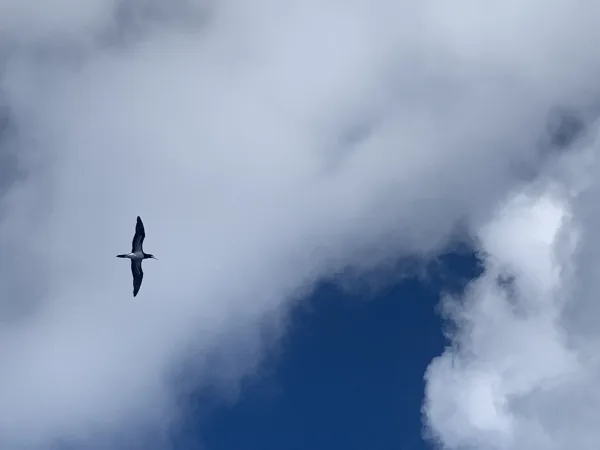Programs Blog
Approaching Hawai’i and Changing Routines

One of two boobies currently visible from the ship (down from half a dozen or so)
Ship’s Log
Winds / Sail Plan
NExN, Force 5
Position
17°59.8’ N x 150°52.9’ W
Log
3246 nautical miles
As we approach Hawai’i (only about 250 nautical miles from the Big Island at the moment), we reach the time when we stop gathering data and start analyzing data. Our twice-a-day habit of heaving to and dunking nets in the water comes to an end (more or less) tomorrow. Instead, all of us students now need to take the vast amounts of data we’ve collected and sift, sort, and stare at it until we come up with some answers to those questions we posed way back on land. As a result, the ship now bears slightly more resemblance to a traditional school. Students can be found sitting at tables with computers, in addition to handling sail or watching hydrocasts rise back to the science deck. The shift takes some getting used to, especially given the constant motion of the boat. However, it’s exciting to return to our questions and begin to find meaning in the forty-some deployments we’ve all conducted. The work of creating figures, crunching numbers, and writing papers will continue as we sail around Hawai’i in the next week and a half.
The end of our data collection has brought with it some new and unique lab procedures. Students are staining and counting bacteria and sorting through old samples in search of larval tuna. Our science team spent many hours preparing solutions for nutrient testing and dissolving chlorophyll in acetone. (These processes culminated in the trippy experience of running small pink vials through a light-sensing machine while listening to instrumental music in a dark, rolling
room.) It also brings an end to our familiar lab routines. We may soon come to miss lowering wires and sorting through buckets in search of tiny sea monsters.
In other news, the weather alternates between sunny and squally, and always windy. We expect to see the tops of Mauna Loa and Mauna Kea around the end of the day tomorrow. Regular shipping traffic has returned, and we now pass within a couple dozen miles of multiple ships each day. (This is a big change from the days when we didn’t see another ship for a week or more.) And most of the boobies have disappeared, although keep that one quiet – they may come back.
– Itai Bojdak-Yates
Contact: Douglas Karlson, Director of Communications, 508-444-1918 | [email protected]
Recent Posts from the Ships
- SEA Writer 2022, Magazines From the Summer SEA Quest Students
- PIPA Alumni Reconnect with Children of Kanton
- Woods Hole Welcomes Incoming Class of PEP Students
- Muhlenberg Student Finds Perfect Study Abroad Experience with SEA Semester
- SEA Student Describes Pacific Exploration for University of Denver News
Programs
- Gap Year
- Ocean Exploration
- High School
- Science at SEA
- SEA Expedition
- SEAScape
- Pre-College
- Proctor Ocean Classroom
- Protecting the Phoenix Islands
- Sargassum Ecosystem
- SPICE
- Stanford@SEA
- Undergraduate
- Climate and Society
- Climate Change and Coastal Resilience
- Coral Reef Conservation
- Marine Biodiversity and Conservation
- MBL
- Ocean Exploration: Plastics
- Ocean Policy: Marine Protected Areas
- Oceans and Climate
- Pacific Reef Expedition
- S-299 Summer Session
- The Global Ocean: Hawai'i
- The Global Ocean: New Zealand